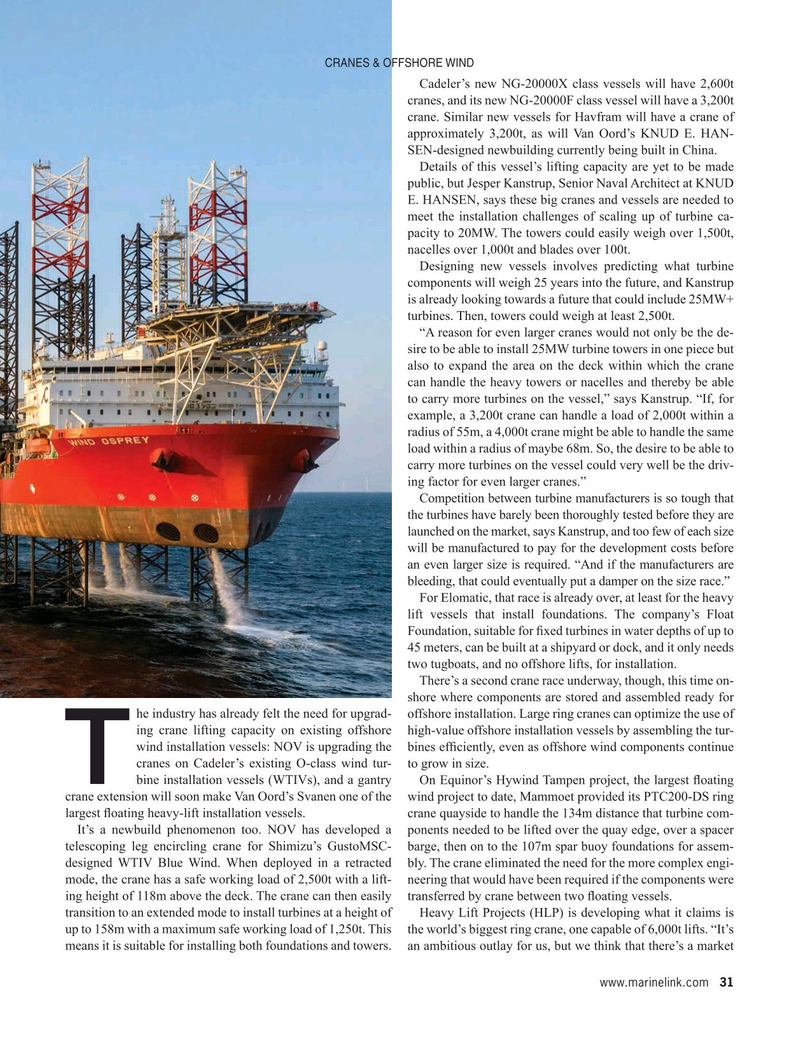
Page 31: of Maritime Reporter Magazine (April 2024)
Read this page in Pdf, Flash or Html5 edition of April 2024 Maritime Reporter Magazine
CRANES & OFFSHORE WIND
Cadeler’s new NG-20000X class vessels will have 2,600t cranes, and its new NG-20000F class vessel will have a 3,200t crane. Similar new vessels for Havfram will have a crane of approximately 3,200t, as will Van Oord’s KNUD E. HAN-
SEN-designed newbuilding currently being built in China.
Details of this vessel’s lifting capacity are yet to be made public, but Jesper Kanstrup, Senior Naval Architect at KNUD
E. HANSEN, says these big cranes and vessels are needed to meet the installation challenges of scaling up of turbine ca- pacity to 20MW. The towers could easily weigh over 1,500t, nacelles over 1,000t and blades over 100t.
Designing new vessels involves predicting what turbine components will weigh 25 years into the future, and Kanstrup is already looking towards a future that could include 25MW+ turbines. Then, towers could weigh at least 2,500t.
“A reason for even larger cranes would not only be the de- sire to be able to install 25MW turbine towers in one piece but also to expand the area on the deck within which the crane can handle the heavy towers or nacelles and thereby be able to carry more turbines on the vessel,” says Kanstrup. “If, for example, a 3,200t crane can handle a load of 2,000t within a radius of 55m, a 4,000t crane might be able to handle the same load within a radius of maybe 68m. So, the desire to be able to carry more turbines on the vessel could very well be the driv- ing factor for even larger cranes.”
Competition between turbine manufacturers is so tough that the turbines have barely been thoroughly tested before they are launched on the market, says Kanstrup, and too few of each size will be manufactured to pay for the development costs before an even larger size is required. “And if the manufacturers are bleeding, that could eventually put a damper on the size race.”
For Elomatic, that race is already over, at least for the heavy lift vessels that install foundations. The company’s Float
Foundation, suitable for ? xed turbines in water depths of up to 45 meters, can be built at a shipyard or dock, and it only needs two tugboats, and no offshore lifts, for installation.
There’s a second crane race underway, though, this time on- shore where components are stored and assembled ready for he industry has already felt the need for upgrad- offshore installation. Large ring cranes can optimize the use of ing crane lifting capacity on existing offshore high-value offshore installation vessels by assembling the tur- wind installation vessels: NOV is upgrading the bines ef? ciently, even as offshore wind components continue cranes on Cadeler’s existing O-class wind tur- to grow in size.
T bine installation vessels (WTIVs), and a gantry On Equinor’s Hywind Tampen project, the largest ? oating crane extension will soon make Van Oord’s Svanen one of the wind project to date, Mammoet provided its PTC200-DS ring largest ? oating heavy-lift installation vessels. crane quayside to handle the 134m distance that turbine com-
It’s a newbuild phenomenon too. NOV has developed a ponents needed to be lifted over the quay edge, over a spacer telescoping leg encircling crane for Shimizu’s GustoMSC- barge, then on to the 107m spar buoy foundations for assem- designed WTIV Blue Wind. When deployed in a retracted bly. The crane eliminated the need for the more complex engi- mode, the crane has a safe working load of 2,500t with a lift- neering that would have been required if the components were ing height of 118m above the deck. The crane can then easily transferred by crane between two ? oating vessels. transition to an extended mode to install turbines at a height of Heavy Lift Projects (HLP) is developing what it claims is up to 158m with a maximum safe working load of 1,250t. This the world’s biggest ring crane, one capable of 6,000t lifts. “It’s means it is suitable for installing both foundations and towers. an ambitious outlay for us, but we think that there’s a market www.marinelink.com 31
MR #4 (18-33).indd 31 4/5/2024 8:28:14 AM

 30
30

 32
32
